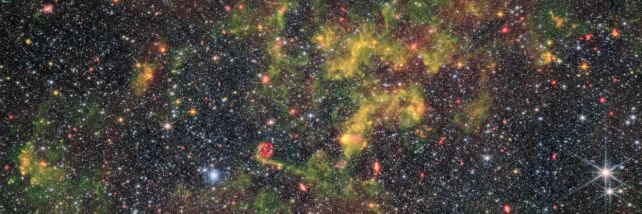The ephemeral configurations of dust and gas in a nearby galaxy glow in a new image from the James Webb Space Telescope.
It's called NGC 6822, or Barnard's Galaxy, and at 1.6 million light-years distant, it's the nearest galaxy to the Milky Way that isn't one of its satellites. It is a small dwarf galaxy, just 7,000 light-years across, and very low in heavy elements, yet most of its stars were born within the last 5 billion years.
This apparent mismatch of properties makes Barnard's Galaxy an excellent laboratory for studying the evolution of galaxies in the early Universe, before there were many metals to go around.
That's because all the elements in the Universe heavier than hydrogen and helium have been made by stars. These giant fiery balls smash atoms together in their cores to make heavier elements all the way up to iron; and, when they explode at the end of their lives, or collide, the extreme violence produces heavier elements still.
Barnard's galaxy has spent most of its lifespan in relative isolation, not interacting with any other objects. This could be one of the reasons why it has such low metallicity: it experienced relatively few gravitational disruptions that could have compressed its dust and gas to trigger star formation. However, sometime around 3 to 4 billion years ago, scientists think it came close enough to the Milky Way for our larger galaxy's gravity to stir things up.
This, as it turns out, is great news for us. We have a nearby object that is low in metallicity that is forming stars, giving us a window into what galaxies in the early Universe might have looked like.

And the JWST is an excellent observatory for the task. Its mid-infrared instrument, MIRI, can see the intricacies of the infrared light emitted by gas; and its near-infrared instrument, NIRCam, renders dust and gas pretty close to invisible, to see the stars it conceals.

The newly released image from JWST combines the views of both instruments. The greeny-yellowy gossamer swirls are the gas and dust; bright red and represent regions of star formation; orange blobs are more distant galaxies; and the dense field of glittering stars permeates it all.

The study of this fascinating galaxy is still ongoing, but the results, hopefully, should help astronomers understand a little bit more about how everything in the Universe began.
Meanwhile, you can download wallpaper-sized versions of the new image from the ESA Webb website.
https://ift.tt/WXhpyTq
Science
No comments:
Post a Comment